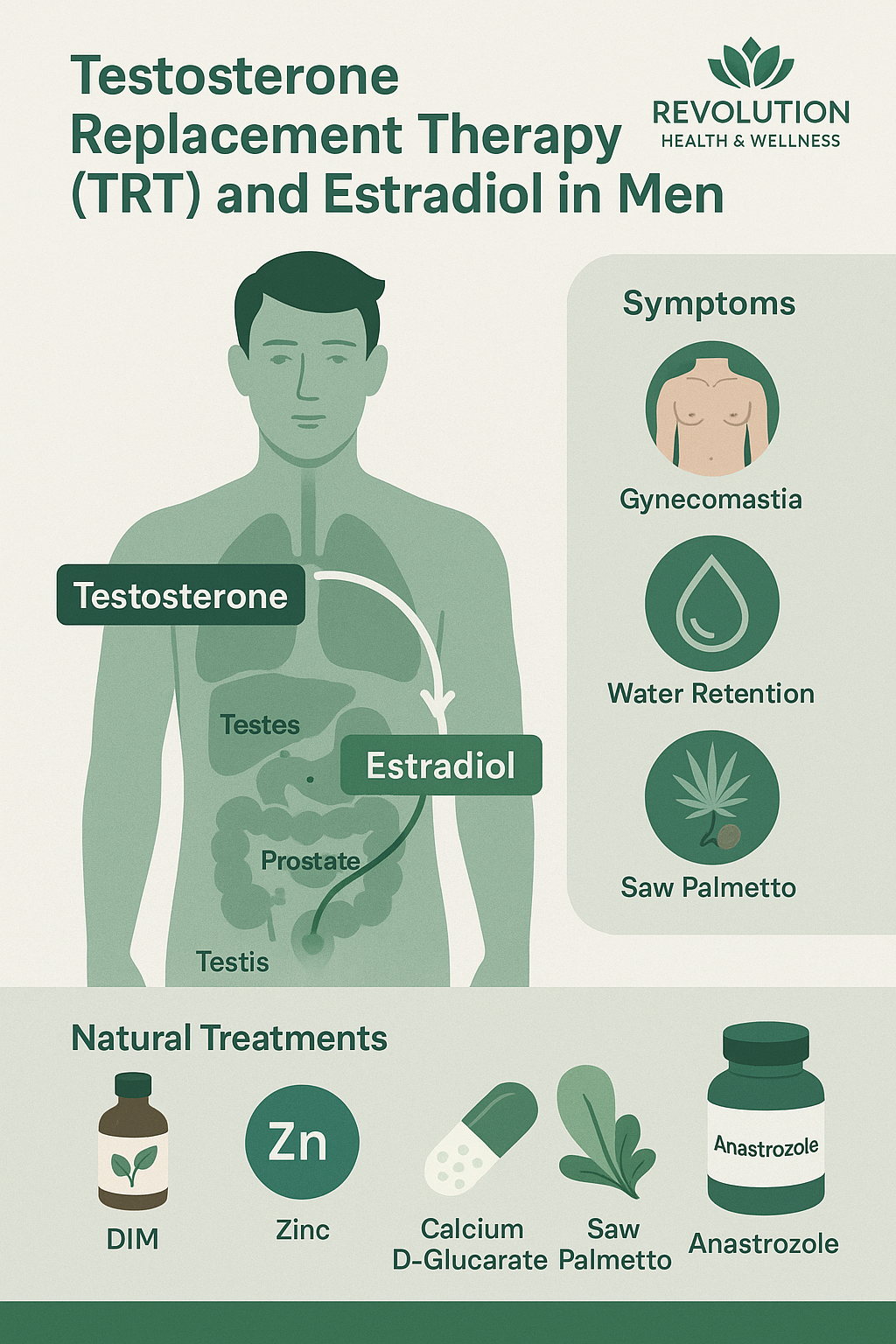Testosterone Replacement Therapy (TRT) and Estradiol Conversion in Men
Overview
Testosterone replacement therapy (TRT) can significantly enhance energy, libido, muscle mass, and mood in men with clinically low testosterone. However, testosterone is often converted (aromatized) into estradiol (E2), a form of estrogen, by the aromatase enzyme. When this occurs excessively, men may experience unwanted effects like gynecomastia, water retention, mood swings, or prostate enlargement.
Who Is at Risk of Elevated Estradiol from TRT?
1. Men with Excess Visceral Fat
-
Aromatase is highly active in fat tissue, especially abdominal fat, increasing estradiol conversion.
2. Older Men
-
Age-related hormonal changes increase aromatization and reduce testosterone clearance.
3. Men on Higher TRT Doses
-
Excess testosterone provides more substrate for aromatization.
4. Liver Dysfunction
-
Alcohol use or liver disease impairs estrogen clearance.
5. Genetic Predisposition
-
Polymorphisms in CYP19A1 (aromatase gene) may increase conversion rates.
Symptoms of Elevated Estradiol in Men on TRT
-
Gynecomastia (breast tissue growth)
-
Nipple sensitivity
-
Water retention or bloating
-
Emotional lability
-
Decreased libido or erectile dysfunction
-
Increased body fat
-
Worsening prostate symptoms or LUTS
Testing and Monitoring Estradiol
-
Initial Panel Before TRT:
-
Total testosterone
-
Estradiol (LC-MS/MS sensitive assay is the best but most expensive)
-
FSH and, occasionally, prolactin
-
PSA, CMP, CBC
-
-
Follow-Up:
-
Recheck estradiol 4–8 weeks after TRT initiation or dosage change
-
Ideal range: 20–40 pg/mL, but varies per individual
-
How to Manage Elevated Estradiol
Aromatase Inhibitors (AIs)
Anastrozole (Arimidex)
-
Mechanism: Inhibits the aromatase enzyme.
-
Starting Dose: 0.125–0.5 mg 1–2x/week
-
Risks: Overuse may cause low libido, joint pain, cognitive changes, bone loss
-
Monitoring: Track estradiol and symptoms every 8–12 weeks after dose change
Note: Not all men require an AI. Only treat when estradiol is elevated and causing symptoms.
Natural Strategies to Support Estradiol Balance and Prostate Health
1. Zinc (30–50 mg/day)
-
Naturally inhibits aromatase
-
Supports prostate and testosterone production
- Also included in our Prostate Health
2. DIM (Diindolylmethane)
-
Found in cruciferous vegetables; improves estrogen metabolism
-
Supports conversion to less active estrogen metabolites
-
Best taken as part of our Hormone Balance supplement
3. Calcium D-Glucarate
-
Supports liver detoxification via glucuronidation
-
Reduces reabsorption of estrogen from the gut
-
Works synergistically with DIM
4. Omega-3 Fatty Acids
-
Anti-inflammatory; reduce aromatase activity
-
Consider Omega 1300 for high-dose triglyceride form
5. Saw Palmetto
-
Inhibits 5-alpha-reductase; supports healthy DHT metabolism
-
Promotes healthy prostate size and function
-
Included in our Prostate Health supplement
6. Lycopene
-
Powerful antioxidant found in tomatoes
-
Prostate-protective
7. Curcumin
-
Anti-inflammatory and may reduce aromatase
-
Our Curcumin Complex is formulated for maximum bioavailability
Prostate Health Considerations
Does TRT Increase Prostate Cancer Risk?
-
No. Multiple large studies show no increased risk in healthy men.
Monitoring:
-
PSA at baseline, 3 months, then every 6–12 months
-
Lower Urinary Tract Symptom (LUTS) questionnaire
Supplement Support:
-
Use Prostate Health for saw palmetto, pygeum, stinging nettle
-
Add zinc, DIM, lycopene, and calcium D-glucarate to maintain optimal estrogen metabolism
Functional Medicine Perspective
We always ask: Why is estrogen high? Instead of just suppressing estradiol, we aim to fix the root cause.
Root-Cause Approach
-
Reduce visceral fat
-
Support liver detox pathways (glucuronidation, sulfation, methylation)
-
Improve gut microbiome for estrogen clearance
-
Encourage daily bowel movements (prevent estrogen recirculation)
Detox Support:
-
ProbioHealth 350: gut support
-
Immuno-30: immune and GI barrier support
-
NAC, glutathione, and milk thistle for liver detox
Treatment Summary Table
| Scenario | Treatment Strategy |
|---|---|
| Normal E2, no symptoms | Monitor only |
| Elevated E2 + symptoms | Add Anastrozole 0.125–0.25 mg 1–2x/week, DIM, zinc |
| Mild E2 elevation + mild symptoms | Try DIM, Calcium D-Glucarate, zinc first |
| Prostate symptoms | Add Prostate Health, lycopene, DIM, test E2/DHT |
| Gynecomastia | Anastrozole + evaluate surgical referral if persistent |
Final Thoughts: Your Hormones, Your Health
Testosterone therapy can help men regain vitality—but only when it's balanced. Managing estradiol levels is essential for prostate health, mood, libido, and body composition.
Use targeted supplements like Hormone Balance, Prostate Health, and Calcium D-Glucarate to support safe, effective testosterone therapy.
Need Help Personalizing Your TRT Plan?
Schedule a TRT consult at Revolution Health. Our expert team will guide you through safe testosterone optimization, estrogen management, and personalized supplementation—so you can feel your best at any age.
Scientific References
-
Finkelstein JS, et al. N Engl J Med. 2013.
-
Morgentaler A. Eur Urol. 2006.
-
Bhasin S, et al. J Clin Endocrinol Metab. 2018.
-
Rhoden EL, Morgentaler A. N Engl J Med. 2004.
-
Shapiro J, et al. Fertil Steril. 2015.
-
Ramasamy R, et al. Asian J Androl. 2016.
-
Vigen R, et al. JAMA. 2013.


